5145 Pholus is an eccentric centaur in the outer Solar System, approximately 180 kilometers in diameter, that crosses the orbit of both Saturn and Neptune. It was discovered on 9 January 1992 by American astronomer David Rabinowitz (uncredited) of UA's Spacewatch survey at the Kitt Peak National Observatory in Arizona, United States. The very reddish object has an elongated shape and a rotation period of 9.98 hours. It was named after the centaur Pholus from Greek mythology.

1620 Geographos is a highly elongated, stony asteroid, near-Earth object and potentially hazardous asteroid of the Apollo group, with a mean diameter of approximately 2.5 km (1.6 mi). It was discovered on 14 September 1951, by astronomers Albert George Wilson and Rudolph Minkowski at the Palomar Observatory in California, United States. The asteroid was named in honor of the National Geographic Society.
2063 Bacchus, provisional designation 1977 HB, is a stony asteroid and near-Earth object of the Apollo group, approximately 1 kilometer in diameter. The contact binary was discovered on 24 April 1977, by American astronomer Charles Kowal at the Palomar Observatory in California, United States. It was named after Bacchus from Roman mythology.
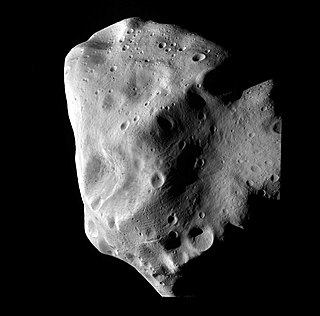
M-type asteroids are a spectral class of asteroids which appear to contain higher concentrations of metal phases than other asteroid classes, and are widely thought to be the source of iron meteorites.

1566 Icarus is a large near-Earth object of the Apollo group and the lowest numbered potentially hazardous asteroid. It has an extremely eccentric orbit (0.83) and measures approximately 1.4 km (0.87 mi) in diameter. In 1968, it became the first asteroid ever observed by radar. Its orbit brings it closer to the Sun than Mercury and further out than the orbit of Mars, which also makes it a Mercury-, Venus-, and Mars-crossing asteroid. This stony asteroid and relatively fast rotator with a period of 2.27 hours was discovered on 27 June 1949, by German astronomer Walter Baade at the Palomar Observatory in California. It was named after the mythological Icarus.
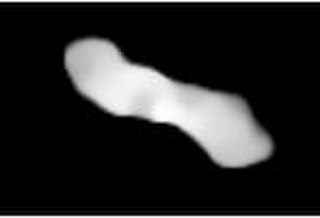
216 Kleopatra is a large M-type asteroid with a mean diameter of 120 kilometers and is noted for its elongate bone or dumbbell shape. It was discovered on 10 April 1880 by Austrian astronomer Johann Palisa at the Austrian Naval Pola Observatory, in what is now Pula, Croatia, and was named after Cleopatra, the famous Egyptian queen. It has two small minor-planet moons which were discovered in 2008 and later named Alexhelios and Cleoselene.
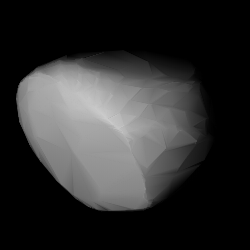
1036 Ganymed, provisional designation 1924 TD, is a stony asteroid on a highly eccentric orbit, classified as a near-Earth object of the Amor group. It was discovered by German astronomer Walter Baade at the Bergedorf Observatory in Hamburg on 23 October 1924, and named after Ganymede from Greek mythology. With a diameter of approximately 35 kilometers, Ganymed is the largest of all near-Earth objects but does not cross Earth's orbit. The S-type asteroid has a rotation period of 10.3 hours. In October 2024, it is predicted to approach Earth at a distance of 56,000,000 km; 35,000,000 mi (0.374097 AU).
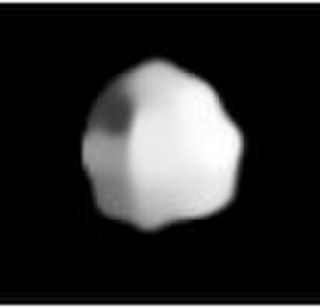
18 Melpomene is a large, bright main-belt asteroid that was discovered by J. R. Hind on 24 June 1852, and named after Melpomenē, the Muse of tragedy in Greek mythology. Its historical symbol was a dagger over a star; it is in the pipeline for Unicode 17.0 as U+1CECB .
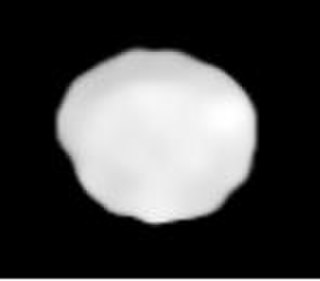
19 Fortuna is one of the largest main-belt asteroids. It has a composition similar to 1 Ceres: a darkly colored surface that is heavily space-weathered with the composition of primitive organic compounds, including tholins.
The Eunomia or Eunomian family is a large asteroid family of S-type asteroids named after the asteroid 15 Eunomia. It is the most prominent family in the intermediate asteroid belt and the 6th-largest family with nearly six thousand known members, or approximately 1.4% of all asteroids in the asteroid belt.
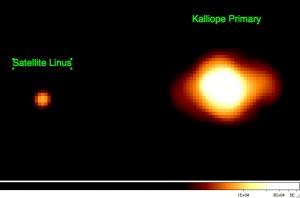
22 Kalliope is a large M-type asteroid from the asteroid belt discovered by J. R. Hind on 16 November 1852. It is named after Calliope, the Greek Muse of epic poetry. It is orbited by a small moon named Linus.

2100 Ra-Shalom is an asteroid and near-Earth object of the Aten group on an eccentric orbit in the inner Solar System. It was discovered on 10 September 1978, by American astronomer Eleanor Helin at the Palomar Observatory, California, who named it in commemoration of the Camp David Peace Accords. The C-type asteroid has a rotation period of 19.8 hours and measures approximately 2.7 kilometers in diameter.

1627 Ivar is an elongated stony asteroid and near-Earth object of the Amor group, approximately 15×6×6 km. It was discovered on 25 September 1929, by Danish astronomer Ejnar Hertzsprung at Leiden Southern Station, annex to the Johannesburg Observatory in South Africa. It was named after Ivar Hertzsprung, brother of the discoverer. 1627 Ivar was the first asteroid to be imaged by radar, in July 1985 by the Arecibo Observatory.

A contact binary is a small Solar System body, such as a minor planet or comet, that is composed of two bodies that have gravitated toward each other until they touch, resulting in a bilobated, peanut-like overall shape. Contact binaries are distinct from true binary systems such as binary asteroids where both components are separated. The term is also used for stellar contact binaries.

(185851) 2000 DP107 is a sub-kilometer sized asteroid, classified as potentially hazardous asteroid and near-Earth object of the Apollo group that is notable because it provided evidence for binary asteroids in the near-Earth population. The PROCYON probe developed by JAXA and the University of Tokyo was intended to flyby this asteroid before its ion thruster failed and could not be restarted.

1580 Betulia, provisional designation 1950 KA, is an eccentric, carbonaceous asteroid, classified as near-Earth object of the Amor group, approximately 4.2 kilometers in diameter. It was discovered on 22 May 1950, by South African astronomer Ernest Johnson at the Union Observatory in Johannesburg. The asteroid was named for Betulia Toro, wife of astronomer Samuel Herrick.
11066 Sigurd (provisional designation 1992 CC1) is a stony contact binary asteroid classified as near-Earth object of the Apollo group of asteroids, approximately 2.5 kilometers in diameter.

Tupan Patera is an active volcano on Jupiter's moon Io. It is located on Io's anti-Jupiter hemisphere at 18.73°S 141.13°W. Tupan consists of a volcanic crater, known as a patera, 79 kilometers across and 900 meters deep. The volcano was first seen in low-resolution observations by the two Voyager spacecraft in 1979, but volcanic activity was not seen at this volcano until June 1996 during the Galileo spacecraft's first orbit. Following this first detection of near-infrared thermal emission and subsequent detections by Galileo during the next few orbits, this volcano was formally named Tupan Patera, after the thunder god of the Tupí-Guaraní indigenous peoples in Brazil, by the International Astronomical Union in 1997.
In astronomy, a phase curve describes the brightness of a reflecting body as a function of its phase angle. The brightness usually refers the object's absolute magnitude, which, in turn, is its apparent magnitude at a distance of one astronomical unit from the Earth and Sun.















